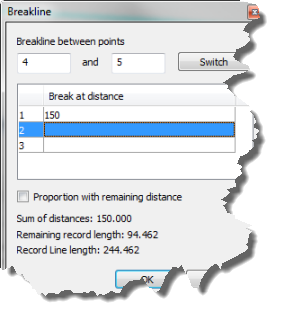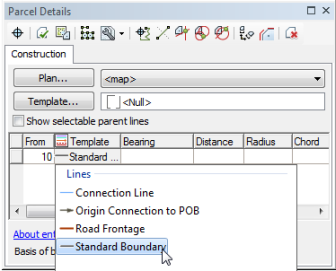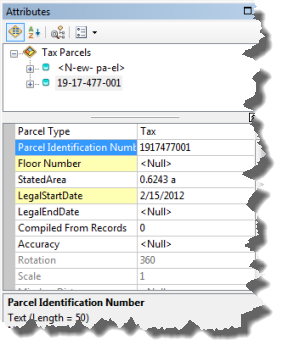Available with Standard or Advanced license.
This topic applies to ArcGIS for Desktop Standard and ArcGIS for Desktop Advanced only.
This workflow describes the steps for splitting parent parcel geometry using construction lines.
The workflow is similar to the Parcel Split: Metes and Bounds workflow, but instead uses construction lines to split the geometry of an existing, parent parcel and build new parcels. Construction lines are traversed between the points of the existing parcel instead of a new, closed-loop parcel traverse being entered.
The workflow uses the sample dataset downloaded with the Tax Parcel Editing map on the ArcGIS Solutions website. To use the automated workflows on the sample data, enable the parcel fabric in the ParcelEditing feature dataset with the Local Government Information Model and drag the parcel fabric into an empty map document.
To start the Parcel Split: Parent Parcel automated workflow, open the Parcel Workflows dialog box by clicking Parcel Editor > Parcel Workflows. Select Parcel Split: Parent Parcel and click Begin workflow.
The workflow consists of the components shown in the diagram below:

Legal description
A legal description for a parcel split using existing parcel geometry may look like this:
The northeast corner of parcel 19-21-301-029 described as; beginning in the northeast corner, S 20-27-03 W 150 FT along ROW, TH N 75-09-00 W 108.22 FT, TH N 87-02-15 W 63.019 FT, TH N 13-22-40 W 127.946, TH S 86-34-44 E 250 FT to POB.
Search for parent parcel
- Open the TaxParcelEditingMap document located in the MapsandGeodatabase folder or drag the parcel fabric (enabled with the Local Government Information Model) in the ParcelEditing feature dataset into an empty map document.
- In the Table Of Contents window, make only the Tax Parcels layer and the Tax Lines Anno layer selectable.
- Make sure that the Lines sublayer (under the Parcel Fabric group layer) is visible.
- Search for the parent parcel or parcels that will used for the split. In the sample data, search for parcel 1921301029.
For this workflow using the sample data, the visibility of the Lots and Units layer and Historic Parcels layer has been turned off.
Select parent parcel
- Start an edit session and use the Select Parcel Features tool
 located on the Parcel Editing toolbar to select the parcel that will be used for the split. In the TaxParcelEditingMap using the sample dataset, select parcel 19-21-301-029.
located on the Parcel Editing toolbar to select the parcel that will be used for the split. In the TaxParcelEditingMap using the sample dataset, select parcel 19-21-301-029.There is a PLSS parcel underlying parcel 19-21-301-029, so you will need to use the selection chip to select parcel 19-21-301-029.
Construct and build new parcels
The geometry of the selected parent parcel will be used to build new parcels.
- Right-click the selected parcel and click Construct From Parent.
- Right-click the eastern boundary of the parcel and click Breakline.
Make sure to right-click near the northern end point of the boundary line.
- On the Breakline dialog box, make sure the breakline is going in the right direction, which is from north to south in the sample data. You can click Switch to change the direction of the breakline.
- Click the first field under Break at distance, type 150, and press ENTER. Click OK.
- Right-click the northern boundary line near the north-east corner point and click Breakline.
- On the Breakline dialog box, make sure the breakline is going from east to west.
- Type 250 in the first field under Break at distance and press ENTER. Click OK.
- Click the construction point that was created on the eastern boundary line to add it as the first from point in the Construction grid on the Parcel Details dialog box.
- Click under the Template field and choose the Standard Boundary line template.
The template field name is initially collapsed to a single icon. You can expand the field to display the field name, which is Template.
- Click the Bearing field and type 75-09-0-4 (-4 is the NW quadrant-bearing shortcut).
- Press ENTER to move to the Distance field and type a distance of 108.22. Press ENTER to move to the next row in the Lines grid.
- For the second split-line, leave the line template set to Standard Boundary and type a bearing of 87-02-15-4 and a distance of 63.02.
The Standard Boundary line template will be used for the remaining traverse legs.
- For the third split line, type a bearing of 13-22-40-4 and a distance of 127.95.
- Click Template to open the Select Feature Template dialog box and choose the Tax Parcels feature template for the new split parcels.
- Click the Build Parcels
 arrow on the Parcel Details dialog box and choose Build and mark Historic.
arrow on the Parcel Details dialog box and choose Build and mark Historic. The original parent parcel is saved as historic and new parcels are built from the construction lines. New parcels are named <New parcel> by default.



Data entry in the lines traverse grid is designed to work with the 10-key pad, where you can use a single hand to enter dimensions. Use quadrant-bearing shortcuts and press the ENTER key and ARROW keys to move between cells.
If the to point of a traverse line does not snap or close on to the expected end point, this indicates an error in either the traverse lines or in the existing parcel.

Annotate parcels
- Make sure the Tax Lines Anno layer is turned on in the Table Of Contents window.
- With the new parcels selected, click the Annotate Parcel Courses tool
 on the Parcel Editor toolbar.
on the Parcel Editor toolbar. - Select ParcelDimensions - 1:1200 on the Annotate Selected Features dialog box and click OK.
Click Yes to re-create annotation.
- If necessary, use the Edit Annotation tool
 to edit and change the placement of the generated annotation.
to edit and change the placement of the generated annotation.
In the TaxParcelEditingMap document, new annotation is not automatically created when new parcels are added.
Annotation is created using the Annotate Parcel Courses tool  , which handles the duplication of annotation on parcel lines.
, which handles the duplication of annotation on parcel lines.
Attribute parcels
The final step in the workflow is to update the attributes of the new parcels:
- With the new parcels selected, open the Attributes window.
- Select a parcel from the parcel list under Tax Parcels and update attributes such as the Parcel Identification Number, StatedArea, LegalStartDate, and Accuracy.
The LegalStartDate attribute should correspond to the date on the parcel's plan. If the Accuracy attribute is left empty, the value is inherited internally from the plan accuracy. You can override the plan accuracy by specifying a different parcel accuracy. Accuracy values are used in the parcel fabric least-squares adjustment.
- Update the attributes of the next parcel in the list.
- Optionally update the attributes of the historic parcels:
- Turn on the Historic Parcels layer in the Table Of Contents window.
- Use the selection chip to select the historic parcel in the map.
- Open the Parcel Details dialog box and update attributes such as LegalStartDate, LegalEndDate, and Reason Parcel Retired.
